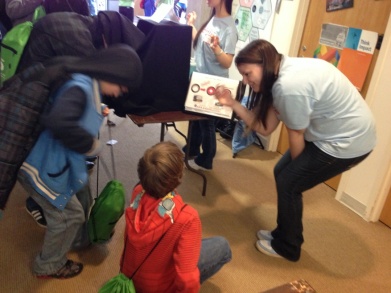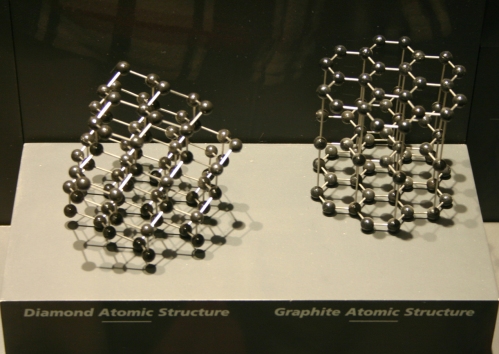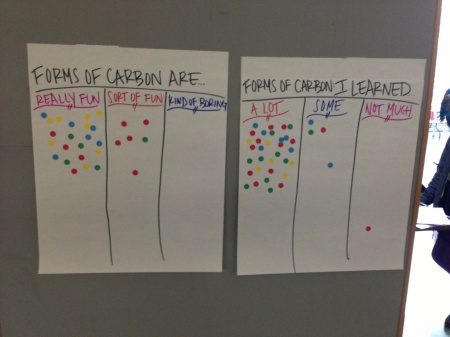“Hey do you guys want to see some fluorescent nanodiamond water?!” I eagerly yelled out as two little boys walked by. Honestly, they probably had no idea what I was talking about, but they still excitedly wandered over. I handed them an ultraviolet flashlight and encouraged them to take a look underneath the black drape we had set up covering up our fluorescent nanodiamond water exhibit at the recent Engineering Expo. This was the beginning of a series of different encounters I had throughout the day which reminded me that everyone, despite their educational background, age, and experiences, is a scientist to some extent.

Both boys spent a good amount of time checking out the nanodiamond water and then just kind of looked at me waiting for an explanation. They sat right down on the ground, almost like it was story time, and waited for me to enlighten them about what they had just seen. However, since to me science is all about stumbling upon your own discoveries and learning by doing I decided to start by asking the boys some questions (let’s call one Ted and the other Steve).
“So what did you guys see when you had your head under the drape?” I asked.
“I saw things glowing!” replied Ted.
To which I responded, “Oh yeah? What colors did you see?”
Steve answered with, “One tube was clear, one was a green, and the other was red.”
Trying to probe for a deeper understanding, I asked, “What do you guys think was glowing?”
Ted, using his surroundings and context clues, quizzically answered, “Nanodiamond?”
Ted happened to be exactly correct! What the demonstration showed were vials of water containing tiny nanodiamond particles wrapped with two different fluorescent dyes (one dye glows green, while the other glows red, just like Steve noticed). The third tube was just regular water without any nanodiamond particles to serve as a reference point (the clear color that Steve pointed out). The nanodiamond particles are so small they do not feel the forces of gravity and as a result float in water. When the two boys shined ultraviolet light on these solutions they were able to see the fluorescent solutions of nanodiamond…just like Steve and Ted pointed out!

After we finished our discussion, I asked them if they had any questions. Ted quickly responded, “No, that was awesome! You covered everything!” On the other hand, I could see the wheels turning in Steve’s head and he looked up at me a little confused and said, “How did they ever find this stuff in the first place?” “What a great question!” I told him, as I proceeded to walk him through the incredible story of how nanodiamond was discovered by multiple research groups in the 1960’s doing nuclear weapons research in the USSR. While Steve was quite satisfied with my explanation, I’ll leave you, the reader, hanging until we cover that story in a later post.
 Steve’s question reminded me of one aspect of my life as a scientist. I ask questions on a daily basis – sometimes to my lab mates, sometimes to Google, and sometimes out loud to myself (this may happen more than I’d like to admit ). These two young boys reminded me of the importance of questioning things you don’t understand or just want to know more about. A three year old Expo attendee, let’s call him Charlie, also taught me a lesson about what it takes to be a scientist. Wanting to know what everyone was looking at, Charlie eagerly led his mother over to the table after seeing the big drape and flashlight. He grabbed the flashlight and shined it in to see the nanodiamond water. While the concepts of fluorescence, nanodiamonds, and even gravity may have been out of his realm, he demonstrated that the curiosity I rely on every day as a scientist is present in children from the start.
Steve’s question reminded me of one aspect of my life as a scientist. I ask questions on a daily basis – sometimes to my lab mates, sometimes to Google, and sometimes out loud to myself (this may happen more than I’d like to admit ). These two young boys reminded me of the importance of questioning things you don’t understand or just want to know more about. A three year old Expo attendee, let’s call him Charlie, also taught me a lesson about what it takes to be a scientist. Wanting to know what everyone was looking at, Charlie eagerly led his mother over to the table after seeing the big drape and flashlight. He grabbed the flashlight and shined it in to see the nanodiamond water. While the concepts of fluorescence, nanodiamonds, and even gravity may have been out of his realm, he demonstrated that the curiosity I rely on every day as a scientist is present in children from the start.

Let’s consider one more example – Jim, a high school junior, who had taken many more science courses than the other characters in our story thus far. Like Charlie, Jim was a curious kid and like Steve and Ted, Jim liked to ask questions – he wanted to know more! We talked about atomic structure – mainly how the atoms in diamond are packed together in such a way that it is much harder than other forms of carbon, such as graphite (which makes up your pencil “lead”). Jim symbolized to me that learning is a lifelong and continuous endeavor. I am constantly learning new things – be it from my own research, that of other members of my group, seminars, etc. Learning definitely occurs on a daily basis! All these kids reminded me that we are all scientists! We all have a certain level of curiosity and desire to learn. I think it’s important to maintain an open mind and innocence and to always ask questions – whether you’re doing scientific research or just hanging out with friends! Sure, the problems I face as a scientist may often be challenging and may not have simple solutions, but keeping an open mind and continuously questioning the outcome is the only way I ultimately reach conclusions. The more curious and passionate I am about what I’m researching, the more invested I am and the more I just want to know the why’s, how’s, what’s, etc – and that’s where discoveries come from! It was great to see these same traits that led me to pursue a career in science in these young kids. And, of course, it is important to remember that science can be fun no matter what level you are at.

